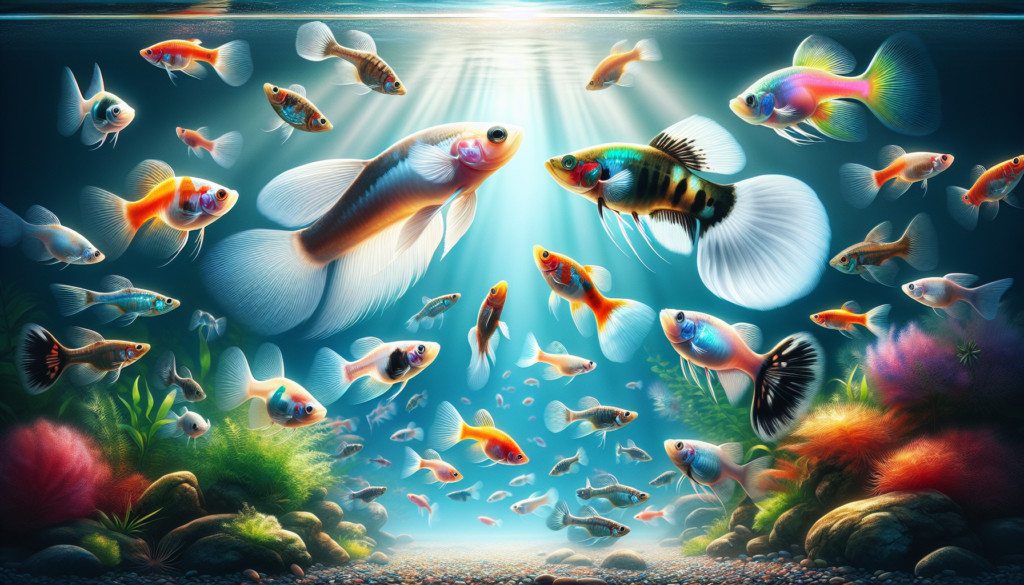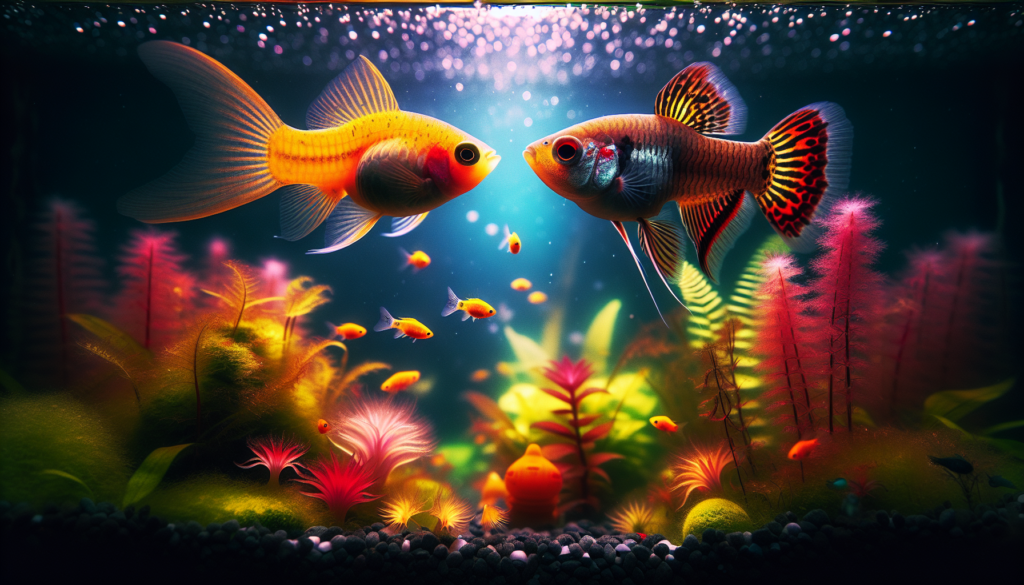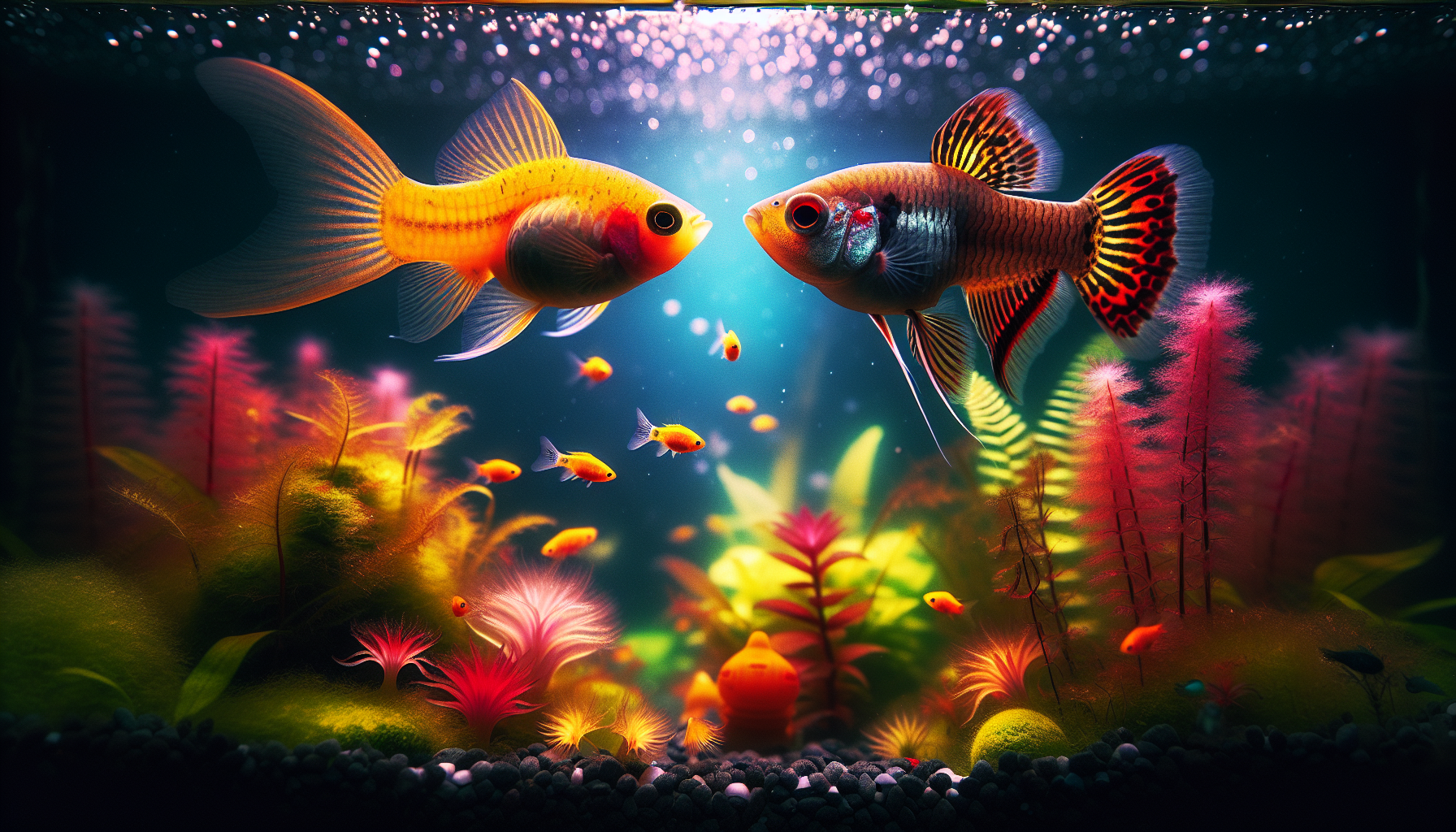Have you ever wondered if mollies and guppies can create new hybrid species through breeding? Well, the answer might surprise you! Many fish enthusiasts have been curious about the possibility of crossbreeding these two popular aquarium favorites. In this article, we will explore the question of whether mollies and guppies can breed together and uncover the fascinating facts behind their reproductive compatibility. Get ready to dive into the world of tropical fish genetics and discover the secrets that lie within these vibrant aquatic creatures!
Characteristics of Mollies
Mollies are small, colorful freshwater fish that are popular among hobbyists due to their vibrant appearance and ease of care. They have elongated bodies with a slightly flattened shape and can grow up to three inches in length. Mollies come in a wide range of colors, including black, orange, white, and gold, with various combinations and patterns. Their fins are typically fan-shaped and can be long and flowing or short and rounded, depending on the specific Molly variety.
Physical Appearance of Mollies
Mollies exhibit a great diversity in their physical appearance, with numerous variations and color patterns available through selective breeding. Some common varieties include the Black Molly, Dalmatian Molly, and Lyretail Molly. The Black Molly is entirely black, while the Dalmatian Molly has a white body speckled with black spots resembling the coat of a Dalmatian dog. The Lyretail Molly boasts a deeply-forked, lyre-shaped tail, adding a graceful touch to its overall appearance.
Mollies’ Natural Habitat
Mollies are native to the warm, brackish waters of Mexico, Central and South America, where they inhabit rivers, streams, and coastal areas. They thrive in environments with moderate water hardness and a pH range of 7.0 to 8.5. Mollies are well-adapted to both freshwater and slightly saline conditions, making them versatile and adaptable to various aquarium setups.
Behavioral Traits of Mollies
Mollies are generally peaceful fish, making them suitable for community tanks. They are active swimmers and social creatures, often found in groups or schools in the wild. Mollies are omnivorous, meaning they consume both plant matter and small invertebrates. They exhibit a voracious appetite and require a varied diet consisting of high-quality flake or pellet food supplemented with live or frozen foods such as brine shrimp, bloodworms, and daphnia. Additionally, Mollies are known for their jumping abilities, so a well-fitted aquarium lid is essential to prevent potential escapes.
Characteristics of Guppies
Guppies are another beloved species among aquarists, known for their striking colors and lively nature. These small fish typically grow up to two inches in length and possess slender bodies with a slightly upturned mouth. Guppies feature bold, iridescent colors, making them a visual delight for aquarium enthusiasts. Their tails are particularly eye-catching, with elongated fins ranging from fan-shaped to veiled or even ribbon-like, depending on the guppy variety.
Physical Appearance of Guppies
Guppies showcase an extensive array of color combinations and patterns, making them an exciting addition to any aquarium. Common guppy varieties include the Cobra, Moscow, and Tuxedo guppies. The Cobra guppy has a striking color pattern resembling the hood of a cobra, with vibrant stripes or spots on its body and tail. Moscow guppies are known for their solid black or metallic blue coloration, while Tuxedo guppies exhibit a unique contrast with a dark body and a brightly colored tail.
Guppies’ Natural Habitat
Native to South America, guppies can be found in freshwater streams, ponds, and even brackish water environments. They are highly adaptable and can tolerate a wide range of water conditions, although they prefer a slightly alkaline pH between 7.0 and 8.0. Guppies thrive in well-planted aquariums that mimic their natural habitat, providing plenty of hiding spots and areas for exploration.
Behavioral Traits of Guppies
Guppies are known for their active and energetic nature, constantly darting around the aquarium. They are generally peaceful and get along well with other non-aggressive fish species, making them suitable for community tanks. Guppies are omnivorous, feeding on both plant matter and small invertebrates. They readily accept a variety of foods, including flake or pellet food, as well as live or frozen treats such as brine shrimp and daphnia. Guppies are also popular for their intriguing mating behaviors, which are characterized by the male’s elaborate courtship displays to attract the female’s attention.
Reproductive Behavior of Mollies
Mollies reproduce through sexual reproduction, with distinct mating processes and reproductive cycles. Male mollies pursuer females with rhythmic movements and vibrant displays, showcasing their elaborate fins and colors to court the female’s favor. Once a female chooses a male, they engage in an intricate mating dance, during which the male transfers sperm to fertilize the eggs within the female’s body. Mollies are livebearers, meaning the fertilized eggs develop internally, and the female gives birth to live offspring.
Mollies’ Mating Process
Mollies have a unique reproductive strategy known as “superfetation.” This means that a female Molly can carry and develop multiple batches of embryos at different stages of development simultaneously. After mating, the fertilized eggs are implanted into the female’s womb-like cavity called the “gonopodium.” The gestation period typically lasts around 30 days, varying depending on water temperature and the female’s health. During this time, the female’s abdomen gradually expands as the fry develop.
Maturity and Fertility of Mollies
Mollies reach sexual maturity at around three to four months of age, although this can vary depending on factors such as diet and environmental conditions. Once sexually mature, female mollies can produce fry approximately every 30 to 60 days. Their fertility rates can be quite high, with a single female Molly capable of giving birth to anywhere from 20 to 100 fry per brood. This rapid reproductive rate, combined with the ability to store sperm for future use, contributes to the Molly’s popularity among breeders.

Development of Molly Fry
After the gestation period, the female Molly gives birth to fully-formed fry with the ability to swim and fend for themselves. Molly fry are relatively large compared to other livebearer species, measuring approximately 0.3 to 0.4 inches in length at birth. They exhibit a wide range of colors and patterns from a young age, showing the influence of their parent mollies’ genetics. To ensure the survival and growth of the fry, it is crucial to provide ample hiding spots, dense vegetation, and a well-balanced diet consisting of crushed flakes and powdered fry food.
Reproductive Behavior of Guppies
Guppies are known for their prolific breeding abilities and fascinating mating rituals. The male guppies use their brightly colored tails and fins to attract females, performing intricate dances and displays to pique their interest. During courtship, the male swims alongside the female and vibrates his body, showcasing his vibrant colors and finnage. If the female is receptive, she will align her ventral fin with the male’s gonopodium, allowing for the transfer of sperm.
Guppies’ Mating Process
Guppy mating often occurs in bursts, with the female releasing a portion of the eggs during each encounter with a male. This strategy, known as “serial mating,” allows for greater genetic diversity within the offspring. The fertilized eggs are then either scattered throughout the tank or attached to plants and other surfaces, where they develop and hatch. The gestation period for guppies lasts approximately 20 to 30 days, depending on water temperature and the female’s health.
Maturity and Fertility of Guppies
Guppies reach sexual maturity within two to three months, but some may exhibit delayed maturity depending on factors such as nutrition and water conditions. Once mature, female guppies can store sperm for several months, allowing for multiple broods without the presence of a male. They are capable of producing fry roughly every 30 to 40 days, with each brood consisting of 20 to 60 fry, depending on the female’s size and health.
Development of Guppy Fry
Guppy fry are born live and fully capable of swimming and feeding on their own. At birth, they measure around 0.2 to 0.3 inches in length and exhibit a slightly different shape compared to the adults. Over time, they grow and develop the vibrant colors and shapes commonly associated with guppies. Providing a well-planted tank with plenty of hiding places, such as floating plants or intricate mosses, is crucial for the survival and growth of guppy fry.
Potential Genetic Compatibility
While Mollies and guppies share similar characteristics and reproductive strategies, they belong to separate genera and exhibit distinct genetic differences. As a result, successful hybridization between the two species is uncommon, although it can occur under specific circumstances.
Genetic Differences between Mollies and Guppies
Mollies belong to the genus Poecilia, while guppies are classified under the genus Poecilia reticulata. Despite both being members of the Poeciliidae family, their genetic makeup differs significantly. Mollies possess a unique combination of chromosomes, making them incompatible for successful hybridization with guppies. However, certain genetic similarities can still lead to occasional hybrid offspring, albeit with reduced viability and fertility.
Challenges in Hybridization
The genetic differences between Mollies and guppies pose significant challenges in hybridization attempts. Mating between the two species often leads to offspring with impaired development and reduced survival rates. Additionally, the genetic incompatibility can result in poor growth rates, misshapen features, infertility, and various health issues among the hybrid offspring.
Occurrence of Hybrid Offspring
While successful hybridization is rare, it is not impossible for Mollies and guppies to produce hybrid offspring. In cases where hybridization occurs, the resulting offspring may exhibit a combination of traits from both parent species. However, due to the genetic incompatibility, these hybrids often have reduced fertility and face challenges in their overall development and survival.
Conditions for Breeding Mollies and Guppies Together
Breeding Mollies and guppies together requires careful consideration and adherence to specific conditions to maximize their chances of successful reproduction.
Tank Setup and Size
Mollies and guppies both require ample swimming space, so a spacious aquarium is essential. A tank size of at least 20 gallons is recommended for a small group of these fish. Additionally, providing ample hiding spots and dense vegetation, such as live plants or artificial decorations, creates a conducive environment for breeding and adds visual appeal to the aquarium.

Water Parameters
Mollies prefer slightly alkaline water conditions with a pH range of 7.0 to 8.5, while guppies tolerate a wider range of pH levels. Maintaining a pH between 7.0 and 8.0 can accommodate the needs of both species. The water temperature should be kept around 75 to 82 degrees Fahrenheit, as this range promotes optimal breeding conditions for both Mollies and guppies.
Mating Triggers
Both Mollies and guppies exhibit specific triggers that stimulate their mating behaviors. For Mollies, introducing a male and female into a well-established aquarium with stable water conditions, accompanied by high-quality food and regular water changes, can initiate breeding behavior. Similarly, guppies require favorable water conditions, well-rounded nutrition, and a male-female ratio that ensures sufficient female attention to induce successful mating.
Breeding Experiments and Insights
Researchers and hobbyists have conducted numerous studies to explore the potential for Mollies and guppies to breed together, shedding light on their mating behaviors, hybridization outcomes, and survival rates.
Studies Conducted on Mollies and Guppies
Several breeding experiments involving Mollies and guppies have been conducted to assess the possibilities of hybridization and the viability of the resulting offspring. These studies have provided valuable insights into the genetic compatibility, reproductive strategies, and health aspects of both species, contributing to our understanding of their breeding dynamics.
Success Rates of Hybridization Attempts
While successful hybridization remains rare, some studies have reported isolated instances of hybridization between Mollies and guppies, resulting in viable hybrid offspring. However, the success rates of such attempts are generally low, and the viability and fertility of the hybrid offspring are often compromised.
Observations on Hybrid Offspring
Observations on hybrid offspring from Mollies and guppies have revealed a diverse range of characteristics and traits. Hybrid offspring may display a combination of features from both parent species, such as color patterns, fin shapes, and body proportions. However, it is important to note that the survival rates, overall health, and fertility of the hybrid offspring tend to be lower compared to purebred Mollies and guppies.
Hybrid Offspring: Characteristics and Viability
The physical traits, survival rates, and fertility of hybrid offspring resulting from Mollies and guppies vary significantly and are largely dependent on the individual genetic makeup of each offspring.
Physical Traits of Hybrid Offspring
Hybrid offspring can exhibit a wide range of physical traits, often displaying a mix of characteristics from both Mollies and guppies. The color patterns, fin shapes, and body proportions may vary greatly, making each hybrid unique in appearance. However, due to the genetic incompatibility, certain traits may be compromised, resulting in less vibrant colors, misshapen fins, or other abnormalities.
Survival and Health Aspects
Hybrid offspring resulting from Mollies and guppies generally have lower survival rates compared to purebred individuals. This reduced viability is attributed to the genetic incompatibility between the two species. Additionally, the hybrid offspring may be more susceptible to diseases and have compromised immune systems, further impacting their overall health and lifespan.
Fertility and Reproduction of Hybrids
Hybrid offspring resulting from the crossbreeding of Mollies and guppies often face challenges in their fertility and reproductive capabilities. While some hybrids may exhibit partial fertility, their ability to produce viable offspring is generally limited. This reduced fertility further contributes to the rarity of hybridization between Mollies and guppies.
Considerations for Hobbyists
As an aquarist interested in breeding Mollies and guppies, there are several essential considerations to keep in mind to ensure a responsible and ethical approach to breeding.
Purpose of Breeding Mollies and Guppies
Before embarking on any breeding endeavor, it is essential to determine the purpose behind breeding Mollies and guppies. Breeding should be done with a clear goal in mind, whether it be creating unique color variations, enhancing certain traits, or contributing to conservation efforts.
Importance of Genetic Preservation
Preserving the genetic diversity of Mollies and guppies is of utmost importance. Hobbyists should strive to maintain the purity and integrity of each species, avoiding indiscriminate hybridization that may compromise their unique genetic traits. Responsible breeding practices, such as selectively breeding within purebred lines, help ensure the preservation of the species’ inherent characteristics.
Ethical and Responsible Breeding
Breeding Mollies and guppies should be approached with a sense of responsibility and ethical consideration. It is crucial to provide proper care, adequate space, and suitable living conditions to all fish involved in the breeding process. Additionally, ensuring the well-being and health of the hybrid offspring, should they occur, is essential.
Conclusion
Mollies and guppies are fascinating fish species with unique characteristics, behaviors, and reproductive strategies. While hybridization between these two species is rare and presents numerous challenges, it can occasionally result in hybrid offspring with a combination of traits from both parent species. However, it is important to approach breeding with thoughtful consideration for the genetic preservation of each species and a commitment to responsible and ethical practices. By understanding the characteristics, natural habitats, and behaviors of Mollies and guppies, hobbyists can enhance their knowledge and appreciation for these captivating fish while ensuring their well-being and long-term survival.
